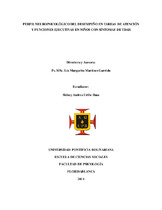Perfíl neuropsicológico del desempeño en tareas de atención y funciones ejecutivas en niños con síntomas de TDAH
Fecha
2013-11-05Director/Asesor
Martínez Garrido, Lía Margarita
Tipo de contenido
bacherlorThesis
Citación
Metadatos
Mostrar el registro completo del ítemDocumentos PDF
Resumen
El Trastorno por Déficit de Atención con Hiperactividad (TDAH) genera en quien lo padece dificultades en la atención y en las funciones ejecutivas, alterando el desempeño académico, social y personal. Por lo anterior, el presente estudio tuvo como objetivo evaluar el desempeño en tareas de atención y funciones ejecutivas (FE) en niños con síntomas asociados al TDAH. Para esto, se aplicaron una serie de instrumentos: formatos de registro (consentimiento informado, historia clínica y CheckList) y pruebas de evaluación neuropsicológica (WISC-R, Test de Colores y Palabras Stroop y el Test de Clasificación de Tarjetas de Wisconsin -WSCT), con éstos instrumentos se evaluó la atención y algunas de las FE más afectadas en los niños con el trastorno: flexibilidad cognitiva, razonamiento abstracto y creatividad. Se seleccionó una muestra de 38 niños de ambos géneros, con edades comprendidas entre los 7 y 15 años, pertenecientes a colegios públicos y privados de Bucaramanga. A partir de la muestra se conformaron dos grupos: control (19 niños sin presencia de TDAH) y experimental (19 niños con presencia de TDAH). Los resultados del estudio no mostraron diferencias estadísticamente significativas en cuanto al desempeño en el Test de Stroop al comparar los dos grupos; sin embargo, al comparar entre sí los diferentes subtipos de TDAH, se hallaron diferencias estadísticamente significativas, específicamente en palabra-color, donde el subtipo TDAH-H arrojó un mejor desempeño que el subtipo TDAH-I. Adicionalmente, no se encontró una diferencia estadísticamente significativa entre el grupo experimental y control en el WCST, ni tampoco al comparar entre subtipos de TDAH el desempeño en este test. En cuanto a la variable género, las niñas tuvieron mejor desempeño que los niños en el Test de Stroop, con relación a palabra-color e interferencia. Además, en la variable edad se encontró una correlación positiva con el WSCT, demostrando que a medida que aumenta la edad aumentan las respuestas correctas, y los errores no perseverativos; y una correlación negativa entre la edad, los errores y los errores perseverativos; en el desempeño de la tarea del Test de Stroop, se encontró una correlación negativa, entre las variables edad, color, palabra-color e interferencia, indicando que a medida que la edad aumenta el desempeño en el test disminuye. The Attention Deficit Disorder with Hyperactivity (ADHD) generates attention problems and deficit in executive functions, disturbing the academic performance, social relationships and personal live. Because of this, the present study has as aim to evaluate the performance in attention tasks and executive functions of children with symptoms associated with ADHD. For this reason, there have been applied a series of instruments: register formats (informs, medical histories and Check Lists) and neuropsychological tests (WISC-R, Test Stroop Color and Word Test and the Wisconsin Card Sorting-WSCT). Those instruments have been used to evaluate attention and executive functions in the most affected children with ADHD in the next areas: cognitive flexibility, abstract reasoning and creativity. As a sample have been taken 38 children (both genders), between 7 and 15 years, form public and private education in Bucaramanga city. Those children were divided in two groups: control group (19 children without ADHD symptoms) and experimental group (19 children with related symptoms with ADHD). The results has not shown a significant statistic differences between the performance into both groups in the Stroop Test and WSCT, but between the ADHD-H and ADHD-I subtypes there were significant differences in the Stroop sub-test word-color, where the first group showed a better performance. Additionally, there was no significant statistic difference between the subtypes of ADHD in the WCST. Regarding the variable gender, female perform was better on the Stroop test than male perform in word-color and interference. In addition, the age variable was a positive correlation with WSCT, showing that as age increases increase the correct answers, and perseverative errors, and a negative correlation between age, errors and perseverative errors, in performance of the task of Stroop test, we found a negative correlation between the variables of age, color, and color word interference, indicating that as age increases in test performance decreases.
Palabra/s clave
Tesis y disertaciones académicas
Rendimiento
TDAH
Niños - enfermedades
Niños hiperactivos
Trastornos por déficit de atención con hiperactividad
Colecciones
- Trabajos de grado [6688]


